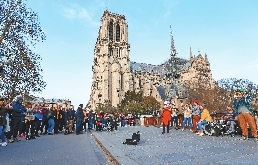
THE iconic cathedral has been deeply enmeshed in Paris’s history since construction began at the end of the 12th century — historians generally ascribe the date 1163 — and lasted more than two centuries to 1345. It was in Notre Dame that Napoleon Bonaparte crowned himself emperor of France. Its massive tenor bell announced the liberation of the city from Nazi control on Aug. 24, 1944. Twenty-six years later it hosted the funeral of Charles de Gaulle, a rare honor for the leader who steered France’s resistance during the war. For French Catholics it has particular resonance, as the resting place of the crown of thorns believed to have been placed on Jesus’ head before his crucifixion. In 1831, Hugo brought the cathedral alive with “Notre Dame de Paris,” giving it a personality on par with the novel’s heroes, the hunchback Quasimodo and the gypsy beauty Esmeralda. In modern times the church became a lodestone of Western culture thanks in large part to its starring role in several movies, not least the “Hunchback of Notre Dame” of 1956. (SD-Agencies) | 
